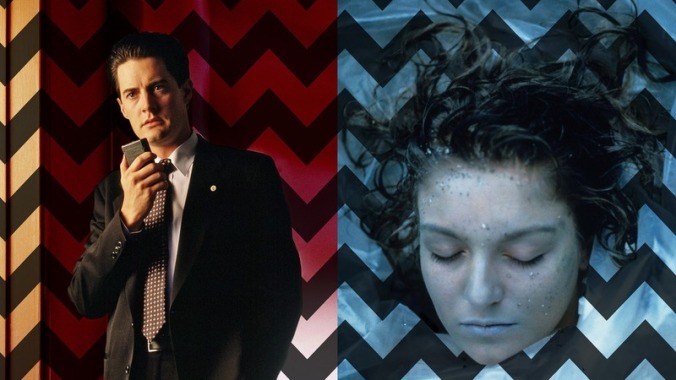All pie, no filler: A 5-step shortcut through Twin Peaks


In 5 To Watch, writers from The A.V. Club make the case for a favored episode from a favorite show. The reasons for their picks might differ, but they can all agree that each episode is a must-watch. In this installment: Twin Peaks, which returns to television on May 21, 26 years after its season two finale. (New episodes air Sundays at 9 p.m. Eastern on Showtime.)
Twin Peaks was influential and monumental TV, a series that set the pace for the medium’s second golden age and left its tattoo on the left shoulder of programs as varied as The X-Files, The Sopranos, and Atlanta. But Mark Frost and David Lynch’s seriocomic surrealist neo-noir is also a cautionary tale, a pop culture phenomenon that caved in under the weight of notes from ABC, tension between Frost and Lynch, a pileup of narrative dead ends, and the pressure of mimicking Lynch’s singular style while the filmmaker was away attending to Wild At Heart. The results are a great TV show that contains some absolutely dire passages, ones that ultimately have no bearing on its conclusion and won’t factor into Showtime’s upcoming reboot. Which is good news for Twin Peaks slackers, who can get everything they need to know about the series from a five-course binge, with the theatrical spin-off Fire Walk With Me serving as both a palate cleanser and an amuse bouche for the new episodes. Doing Twin Peaks in five episodes might leave you feeling a little lost, but don’t sweat it—even when you’ve watched the series front to back multiple times, it can leave you feeling that way.
Pilot
It starts like this: overcast skies, near-wordless tableaus in a lakeside estate, and a conspicuous heap of synthetic material spied amid the natural Pacific Northwest splendor. The discovery of Laura Palmer’s body—“wrapped in plastic,” as sawmill foreman Pete Martell (Jack Nance) infamously drawls—ripples across all of Twin Peaks, but those vibrations are felt most deeply (and melodramatically) in Lynch and Frost’s feature-length pilot, a murder-mystery opener that arranges its key players, suspects, and red herrings as intricately as the doughnut buffet in the soon-to-be-familiar conference room of the Twin Peaks sheriff’s station. “Who killed Laura Palmer?” briefly became the early ’90s version of “Who shot J.R.?”, but the fact that the creators managed to whip up an answer for the pilot’s international version (in footage memorably repurposed elsewhere) indicates that their series was never meant to be about a single crime. Twenty-seven years later, it’s the stuff around the fresh-faced cadaver that makes the first taste of Twin Peaks linger: Agent Cooper (Kyle MacLachlan) getting the unseen Diane (and the viewer) up to speed in one of TV’s all-time great entrances; the surrealism and screwball comedy buzz-sawing through the heavy subject matter; the atmosphere captured in Angelo Badalamenti’s dreamy score. You’ve seen the feature-length premiere episode of Twin Peaks even if you’ve never seen the feature-length premiere episode of Twin Peaks. It’s in the “sunless community rocked by tragedy” openings of Riverdale and The Returned, the idiosyncratic investigators and murder victims full of secrets at the tops of The Killing, Hannibal, and the first season of True Detective. But you’ve never seen it quite like this. [Erik Adams]
“Zen, Or The Skill To Catch A Killer” (season one, episode three)
If any episode of Twin Peaks is preceded by its reputation, it’s this one, whose climactic dream sequence was the subject of much speculation and parody during the show’s time in the zeitgeist. But for all the brain-scrambling awaiting you at the end of “Zen, Or The Skill To Catch A Killer,” there’s no “when are they gonna get to the fireworks factory” factor. Season one’s final Lynch-Frost team-up contains many of Twin Peaks’ signature sequences, like Coop’s metaphysical, rock-based deciphering of a phrase from Laura’s secret diary and the first face-off between testy FBI forensics expert Alfred Rosenfield (Miguel Ferrer) and stalwart sheriff Harry S. Truman (Michael Ontkean). Meanwhile, the residents of Twin Peaks can’t keep from showing their true colors, in ways customary to a prime-time soap—the love triangle once formed by Laura, her brooding-loner lover, James Hurley (James Marshall), and her best friend, Donna (Lara Flynn Boyle)—and not-so-customary. (See: the borderline indecent relationship between Richard Beymer’s richest-man-in-town Benjamin Horne and a baguette filled with brie and butter.) “Zen, Or The Skill To Catch A Killer” represents the unique alchemy that Twin Peaks was able to summon at its best, its narrative drive and flights of fancy working in harmony to create suspicions about the town’s seemingly do-gooder population while inserting enough spontaneous dancing to suggest something stranger’s afoot. And by the time Mike, Bob, and The Man From The Other Place introduce themselves, you’ll know something stranger’s afoot. [Erik Adams]
“May The Giant Be With You” (season two, episode one)
Twin Peaks’ second season gets a lot of flak—from fans, from the cast, even from Lynch himself. And while a lot of that criticism might be earned, the intensity of it speaks to a general impatience about getting somewhere, one unfortunately stoked by the misconception that this is all just a puzzle to be solved, rather than a world to enjoy getting lost in. But hey, you’re trying to blast through this whole thing in five episodes, so that’s all we’ll say on that. If you’re looking to put that puzzle together quickly, Twin Peaks’ double-length second season opener is one of its few truly key pieces, picking up the threads of several dangling cliffhangers—most of them involving key figures getting shot in the first season finale, Agent Cooper among them. It also introduces various new guises for its characters, some of which will be important going forward (Leland Palmer’s [Ray Wise] transformation into a grinning, white-haired, song-and-dance man; Leo Johnson’s [Eric Da Rae] lapse into a coma), and some that, well, won’t (Audrey’s [Sherilyn Fenn] brief, icky undercover run in her father’s brothel; Donna’s makeover as a sunglasses-wearing, cigarette-smoking badass). But no new face is as important as that of the titular Giant (Carel Struycken), who appears before Cooper to lay out a new string of cryptic riddles for him to untangle, as well as to promise that—no matter how methodically the show seemed to have ticked through its possible suspects already, so long as “the owls are not what they seem”—there will always be larger, more compelling mysteries to unlock. “Don’t search for the answers all at once,” the Giant tells Cooper, an admonition that that show (if not its viewers) took to heart. [Sean O’Neal]
“Lonely Souls” (season two, episode seven)
Laura Palmer’s killer never should have been revealed—or at least, not before David Lynch was good and ready. Given Lynch’s methods, inscrutable even to his closest collaborators and beholden to changes in the wind, the tease could have gone on for years, had the network, a TV audience weaned on tidy resolutions, and some common sense from Frost not intervened. And so, Twin Peaks’ central murder-mystery came, somewhat grudgingly, to a close in the seventh episode of its second season, and it’s to Lynch’s eternal credit that he was able to make even an ostensibly concrete answer as confounding and bewitching as the series’ most chimerical moments. It all begins with the discovery of Laura Palmer’s secret secret diary, found in the residence of poor, sensitive shut-in Harold Smith (Lenny Von Dohlen) in the wake of his suicide, and the multiple references it contains to her father’s “friend” Bob and sexual abuse. But even this last-minute unearthing of a crucial clue, as well as the red herring investigation of Ben Horne it leads to, doesn’t create the standard procedural climax viewers were trained to expect. Instead, it all merely clears the way for another hallucinatory visit to The Roadhouse, where much of the show’s principal cast gathers to listen to Julee Cruise while Cooper has another vision of the Giant warning him, “It is happening again,” as various characters experience a sense of ineffable grief—an emotional prelude to one of Lynch’s most chilling sequences in a filmography full of them. As Leland, revealed to be possessed by the evil Bob, beats Maddy to death, then dances with her corpse while tearfully calling out his daughter’s name, Twin Peaks provides an answer to its central question that only opens up a deeper abyss of heartache and loss. It’s a wonder the network ever allowed it on the air. And while the show would struggle in its wake, the sheer power of that moment almost makes all the James subplots and alien mumbo jumbo worth it. Almost. [Sean O’Neal]
“Beyond Life And Death” (season two, episode 22)
You’re going to miss a lot by skipping from the solution of the Palmer case to the conclusion of the original series—but those who’ve muddled through Twin Peaks’ downward spiral wouldn’t say you’ll miss it, if you catch our drift. Woven between the conclusions of various season two storylines (Nadine’s high school fugue state, the Lucy-Andy-Dick love triangle) and the establishment of cliffhangers doomed to go unresolved (Is Ben Horne Donna’s biological father? Does anyone survive the explosion at the Twin Peaks Savings & Loan?) is Agent Cooper’s trek into the spirit realm previously glimpsed in his dream. The journey into The Black Lodge has its connections to the larger mess of season two, but that, too, can be overlooked for the nightmarish stretch that begins with Sarah Palmer entering the Double R to deliver a voice-distorted message: “I’m in The Black Lodge with Dale Cooper.” Offering little in the way of concrete answers, the sequence gives meaning and weight to all the talk of the presence lurking in the woods, the one that’s been inhabiting owls, haunting local teens, and creeping into Coop’s field of vision. In addition to setting up Twin Peaks’ movie prequel and Showtime sequel, it’s also one of the weirdest fucking things to ever air on broadcast television, Lynch’s command of disorientation and terror feeding vignettes of our valiant hero staring evil right in its milky eyes and refusing to drink its sludgy coffee. Is it the co-creator’s ultimate statement on elegant surfaces hiding grotesque interiors? A surrealist cutup about how even the best of us are doomed to be overpowered by our darkest impulses? And how’s Annie? These are questions for the new Twin Peaks, questions that are bound to raise more questions, to be speculated upon for another quarter century, by the growing ranks of viewers gathering under the sycamore trees. [Erik Adams]